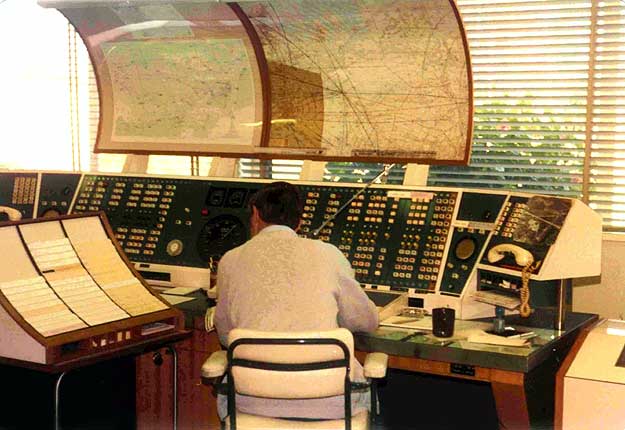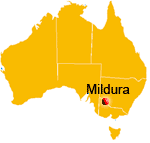
This
photo shows Flight Service Officer (FSO) Paul le Grande 'on watch' at the FS1
position in the Mildura Flight Service Unit (FSU) in about 1974-76. This FSU was
located in a building near the airport terminal. Unlike many FSUs, Mildura did
not front on to the movement area.
The console is of fairly typical 1960s and '70s vintage design common to many of the outstation FSUs. To the operator's left is a portable strip bay sitting on a small table and holding pending strips. The active strips are held on a small table-top bay partly obscured in front of the operator. Strips for IFR aircraft were buff coloured, whilst VFR full-reporting flights had white strips. VFR aircraft operating on either a SARTIME or NOSAR basis had pink strips.
To the right of the console is a teleprinter on which flight plans, movement messages, weather messages and NOTAMs were received. Opposite this console was a briefing desk where pilots could receive a face-to-face briefing from an FSO.
At this time Mildura FSU was responsible for providing traffic information to all aircraft, whether IFR or VFR, within a 15 NM radius Aerodrome Flight Information Zone (AFIZ). All aircraft entering the AFIZ were required to make an initial call 30 NM out, although no-radio aircraft could operate within the AFIZ provided they submitted a flight plan and kept to within +/- 10 minutes of their nominated timing. The FSU was also responsible for providing traffic information to all IFR and many VFR aircraft within a larger, surrounding Flight Information Area (FIA) which encompassed uncontrolled airspace which extended up to Flight Level 200 (20,000 feet). The FSU also operated an Automatic Terminal Information Service (ATIS), which provided a continuous broadcast of current conditions at Mildura airport.
Former FSO Robert Amos, who served for 17 years at Mildura, recalls "The Flight Progress Board was usually arranged with the next action due strip at the bottom, and some operators would place all the SARTIME (pink) strips below the main active strips in order of next SARTIME due. When the active board became full, the SARTIMEs could be placed on a second board beside the one in use. The non-active flight strips were generally scanned and arranged (if room permitted) on the Progress Board below the active strips, separated with a strip with the words ACTIVE/SUSPENSE with arrow pointing up and down. The strips were arranged in order of next action due, e.g. ETD, because this allowed some degree of operational awareness."
"We had (in the 1970's ) a lot of upper air balloon launching from what was known as HIBAL. This of course had significance because of the overlying control airspace which had a lower limit of FL200. Each balloon flight involved huge cost, and had to be carefully planned. Later on this operation was moved to Alice Springs."
The Mildura FSU closed in 1990 when its functions were transferred to Melbourne. The console still exists in the collection of the Airways Museum.

(Photo: Robert Amos)
Back to the main Air Traffic Services index